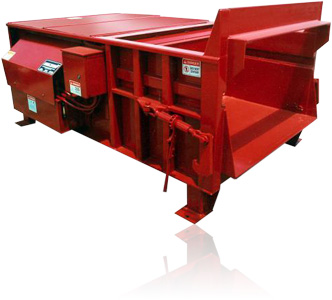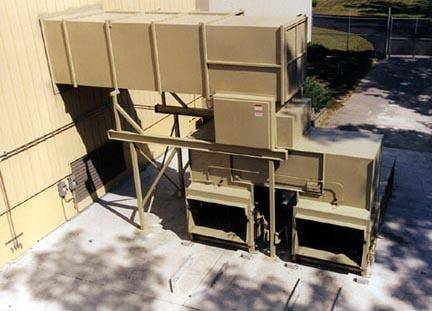How Industrial waste compaction equipment boosts workplace efficiency
Wiki Article
Recognizing the Numerous Uses Waste Tools in the Recycling Market
The recycling sector counts heavily on specialized waste devices to maximize handling and healing. Each tool, from shredders to balers, offers a distinctive objective that enhances overall efficiency. Comprehending these roles is essential for boosting sustainability efforts. Commercial garbage compaction equipment. As modern technology advances, new advancements arise, promising to change standard practices. This evolution increases crucial questions concerning the future of waste management and its influence on environmental conservation. What changes exist in advance for this crucial market?The Role of Shredders in Product Handling
Shredders play an important role in the reusing market by effectively processing different kinds of waste materials. These makers are made to decrease big products, such as plastics, steels, and natural waste, into smaller, convenient pieces. This dimension reduction is crucial for subsequent recycling procedures, as it enables simpler handling and sorting. Along with facilitating recycling, shredders boost security by reducing the danger of injury linked with dealing with cumbersome waste items.Moreover, shredders add to ecological sustainability by ensuring that materials are refined in such a way that makes the most of source recuperation. They can take care of a diverse variety of products, making them flexible tools in waste administration centers. The effective operation of shredders not just streamlines the reusing procedure yet additionally raises the total effectiveness of waste diversion efforts, advertising a circular economic situation. Their importance in material processing can not be overemphasized, as they act as a foundational action in the direction of sustainable waste management methods.

How Balers Enhance Effectiveness in Waste Administration
Balers greatly enhance effectiveness in waste monitoring by condensing different products right into bales, which simplifies storage space and transportation. By pressing recyclables such as cardboard, plastics, and metals, balers significantly reduce the quantity of waste. This compression not only takes full advantage of area in recycling facilities but also minimizes the number of journeys required to move products, resulting in lower gas expenses and decreased environmental influence.Balers add to improved safety and security in waste monitoring operations. Small bales are less complicated to stack and deal with, decreasing the danger of crashes associated with loosened materials. The consistent size of bundles permits for more reliable loading and discharging processes, simplifying procedures within recycling facilities. Additionally, balers can improve the general high quality of recyclables, as correctly compacted products are much less most likely to be contaminated. On the whole, balers play an essential duty in enhancing waste management methods, advertising sustainability in the recycling industry.
Conveyor Equipments: Enhancing the Recycling Refine
Including sophisticated equipment like balers greatly enhances waste monitoring procedures, but the performance of the recycling process is better improved via using conveyor systems. These systems play a necessary duty in the seamless transportation of products within recycling centers. By helping with the motion of various waste types, conveyor systems decrease hands-on handling and reduce the threat of contamination throughout the reusing procedure.Additionally, conveyor systems can be personalized to fit the unique designs and functional needs of reusing centers. Their capability to operate continuously permits a consistent circulation of products, improving performance and ensuring that arranging and refining equipment receives a consistent supply.
Outfitted with features like flexible rates and automated controls, conveyor systems can optimize the circulation of products, greatly improving general efficiency (Commercial garbage compaction equipment). These systems are vital in modern recycling operations, contributing and improving procedures to efficient waste management.
Arranging Machines: The Key to Product Recuperation
Arranging machines are important components in the reusing industry, substantially enhancing the efficiency of product recovery. These machines play a critical role in the splitting up of different recyclable products, allowing for a structured process that optimizes source extraction. By making use of advanced modern technologies, such as optical sensors and air classifiers, arranging devices can determine and categorize products based upon their weight, structure, and size. This capability guarantees that steels, plastics, and paper products are successfully isolated, decreasing contamination and boosting the quality of recycled result.The operation of arranging makers substantially lowers the reliance on manual work, which can be both taxing and prone to mistakes - Commercial garbage compaction equipment. Additionally, the automation supplied by these machines accelerates the general recycling process, leading to greater throughput and raised operational efficiency. Sorting equipments are vital in accomplishing sustainable waste monitoring goals, making it possible for the recycling market to efficiently recoup useful materials while lowering landfill dependence.
Advancements in Waste Equipment for a Sustainable Future
Current developments in waste tools are driving the reusing market towards a more lasting future. Advancements such as automated arranging systems, which make use of expert system and artificial intelligence, enhance effectiveness by accurately determining and dividing recyclables. This leads to greater recuperation rates and reduced contamination. Additionally, growths in compacting technology enable for a lot more efficient transport of materials, reducing carbon footprints during transit.Innovations in shredding devices enhance the handling of complicated materials, making it possible for the recycling of products that were when deemed non-recyclable. The assimilation of renewable resource resources, like solar energy, in waste processing centers additionally adds to sustainability objectives. In enhancement, innovations in waste-to-energy innovations and naturally degradable materials are reshaping the landscape of Commercial trash compaction equipment waste administration. Collectively, these advancements represent a transformative change within the reusing market, promoting not only ecological security yet additionally financial viability for future generations.
Frequently Asked Questions
What Kinds of Materials Can Waste Equipment Take Care Of?
The kinds of products waste tools can handle include plastics, steels, paper, glass, and organic waste. Each equipment kind is designed for particular products, enhancing performance and effectiveness in sorting and processing numerous waste streams.Exactly How Typically Should Waste Devices Be Kept?

Exist Security Worry About Utilizing Waste Devices?
Safety issues with making use of waste tools consist of potential injuries from mechanical malfunctions, exposure to hazardous materials, and inadequate training. Appropriate maintenance, normal inspections, and staff member education are necessary to reduce these threats successfully in any kind of setting.What Is the Average Life-span of Recycling Equipment?
The typical life expectancy of recycling devices commonly varies from 10 to 20 years, depending upon aspects such as use intensity, upkeep techniques, and technical improvements, which can considerably affect toughness and performance with time.Just How Is Waste Equipment Powered in Recycling Facilities?
Waste devices in reusing centers is generally powered by electrical power, though some devices may use alternative power resources like natural gas or diesel. This power makes it possible for effective handling and change of materials for reusing purposes.Shredders play a vital role in the reusing sector by successfully refining different types of waste materials. They can take care of a diverse range of materials, making them flexible tools in waste management facilities. Balers considerably improve efficiency in waste management by condensing various products right into bales, which simplifies storage space and transport. The kinds of products waste devices can deal with consist of plastics, steels, paper, glass, and natural waste. Security concerns with making use of waste equipment include prospective injuries from mechanical breakdowns, exposure to harmful products, and inadequate training.
Report this wiki page